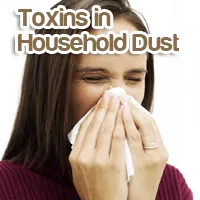
- Share on Facebook1
- Share on Pinterest
- Share on Twitter
Household dust may seem relatively harmless to most people, but toxins can be trapped in dust, posing real health risks.
 According to the Environmental Working Group (EWG), household dust contains everything from skin cells, pet dander, and soil tracked in from outside to carpet fibers, fungal spores, and tiny particles–which can include harmful chemicals.
According to the Environmental Working Group (EWG), household dust contains everything from skin cells, pet dander, and soil tracked in from outside to carpet fibers, fungal spores, and tiny particles–which can include harmful chemicals.
The sources of these harmful chemicals can range from furniture, electronics, plastics and fabric to and outdoor pollutants that enter via open windows or are tracked in on your shoes, clothes, or even your body.
Once inside, the chemicals persist much longer than they would outdoors where moisture and sunlight would break them down much more rapidly, according to the EWG.
Various studies have identified dozens of harmful chemicals in household dust.
A study published in the journal Environmental Science and Technology in 2007 examining the key routes of exposure of polybrominated diphenyl ethers (PBDEs)–a fire retardant–in first-time mothers. The study examined samples of breast milk and collected dust from commonly used areas of the home using a vacuum. Researchers “found statistically significant, positive associations between PBDE concentrations in breast milk and house dust.”
Toxins like PBDEs are additives, and as such, they aren’t chemically bound to plastics, foams and other polymers–and this makes it easier for PBDEs and other additive toxins to separate from objects in your home, leeching into the air and settling in dust.
In another study published in Environmental Science and Technology in 2003, Ruthann A. Rudel and other researchers sampled dust in 120 homes to test for 89 endocrine-disrupting compounds (EDCs)–chemicals that affect hormone systems. A total of 66 of the EDCs were found in the dust samples, with six compounds found in the least-contaminated sample, and 42 EDCs in the most toxic sample. Flame-retardants were found frequently in the dust sampled, and 27 different pesticides were also found–including DDT, heptachlor, chlordane, and methoxychlor, pesticides that have been banned, “suggesting limited indoor degradation,” according to the study.
Even low levels of toxins in dust can be harmful to your health, according to the EWG. Children are at greater risk because their bodies are still developing and vulnerable, and because they spend more time near the floor, where dust accumulates. They’re also prone to putting their hands and toys in their mouth, increasing dust exposure.
Banishing toxic household dust is all about staying on top of cleaning–and using the right tools. The EWG recommends vacuuming regularly with a vacuum that has a HEPA filter, which traps fine particles that other vacuums don’t (and it’s important to replace the HEPA filter regularly so that it’s doing the job intended).
Forget all those dusting brooms and wands with disposable cloths–they’re wasteful and unnecessary. Hard-surface floors should be wet dusted with a mop. If you make this part of your daily routine, it won’t seem like such a chore and the work will be relatively easy. And a dust mop can be shaken out outside–well away from open widows and doors–and thrown in the wash for easy cleaning.
When it comes to furniture, a microfiber cloth is your best friend. The fine fibers cling to small particles, trapping those toxins, dander, skin cells and other dust components. If you don’t have a microfiber cloth, a damp cotton cloth will do the trick. If you’re using synthetic wood cleaner, stop–it just adds more chemicals into your indoor air. Many people use lemon or orange oil, but citrus oils contain d-limonene, a natural toxin, so they’re not great for regular indoor use. A great alternative for untreated woods is linseed oil, which is derived from flax seeds.
– Andrea Donsky and Randy Boyer
Andrea Donsky and Randy Boyer are the founders of NaturallySavvy.com, a website that educates people on the benefits of living a natural, organic and green lifestyle. For more information and to sign up for their newsletter, visit www.NaturallySavvy.com.
(c) 2010, NATURALLY SAVVY DISTRIBUTED BY TRIBUNE MEDIA SERVICES, INC.
- Share on Facebook1
- Share on Pinterest
- Share on Twitter

